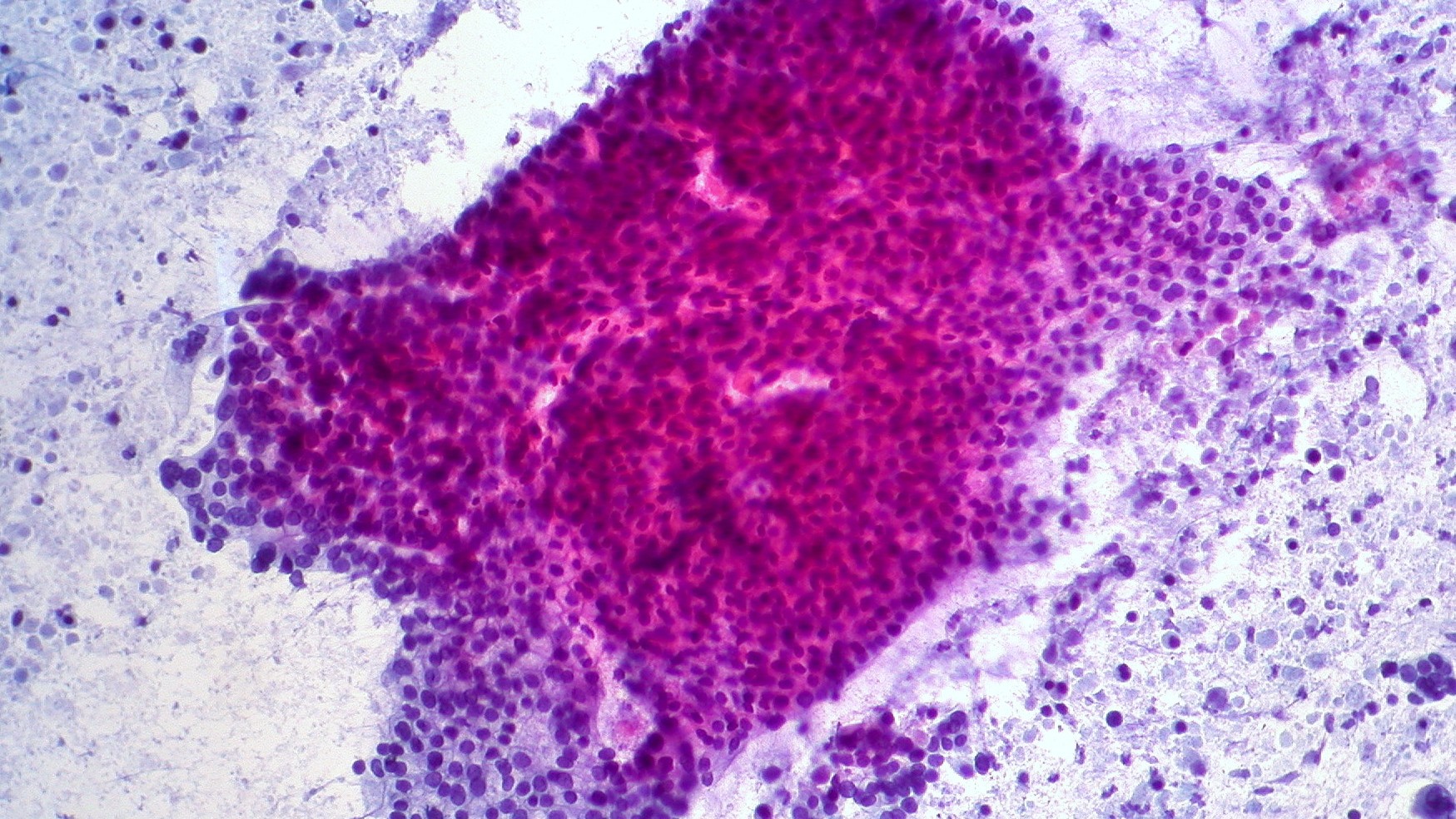The 10 deadliest cancers, and why there's no cure
The deadliest cancers aren't necessarily the ones that kill the most people overall; they're the ones with the lowest survival rates.

- 1. Pancreatic cancer
- 2. Esophageal cancer
- 3. Liver cancer and intrahepatic bile duct cancer
- 4. Lung cancer and bronchus cancer
- 5. Acute myeloid leukemia
- 6. Brain cancer and other nervous system cancer
- 7. Stomach cancer
- 8. Ovarian cancer
- 9. Myeloma
- 10. Laryngeal cancer
- Beyond the SEER list
- Declining cancer death rates
There's no doubt that cancer is deadly: In the United States, the disease is the second-most-common cause of death, after heart disease, according to the Centers for Disease Control and Prevention (CDC). Even when diagnosed and treated early, cancer has the potential to kill.
According to the World Health Organization, the three cancers that killed the most people worldwide in 2020 were lung cancer (1.8 million deaths), colorectal cancer (916,000 deaths) and liver cancer (830,000 deaths). Prostate cancer and breast cancer, meanwhile, are among the most common types of cancer.
But those aren't necessarily the deadliest cancers, in terms of their individual survival rates, Rebecca Siegel, senior scientific director of cancer surveillance research at the American Cancer Society (ACS), told Live Science.
The number of people a given type of cancer kills each year depends on how many people have it and what percentage of people diagnosed with the cancer survive, Siegel explained. The deadliest cancers are those with the lowest survival rates.
Cancer researchers determine these survival rates with a measure called five-year relative survival. This is the percentage of people who are expected to survive the effects of a given cancer, excluding their risk of other possible causes of death, for five years past a diagnosis, according to the Surveillance, Epidemiology, and End Results (SEER) Program, a National Cancer Institute (NCI) initiative that collects, analyzes and reports data on U.S. cancer cases.
It's also important to note that when it comes to cancer, there's not necessarily a "cure." In medical terminology, a cure implies that zero cancerous cells remain in the body, and the cancer will never come back. While modern treatments can excise or shrink cancer to the point it's no longer detectable by imaging or laboratory tests, doctors can't guarantee every cancerous cell is gone. Even once a cancer is undetectable, it's still possible for it to reappear months or years later. For that reason, if treatments are successful, doctors prefer to say a person's cancer is "in remission" rather than "cured." If the cancer is in remission for a very, very long time, some doctors may then say the patient is cured.
Here are the 10 deadliest cancers in the U.S., according to SEER five-year relative survival data for cases diagnosed between 2014 and 2020.
Get the world’s most fascinating discoveries delivered straight to your inbox.
Pancreatic cancer five-year relative survival: 12.8%
Pancreatic cancer has a 12.8% five-year survival rate. It can be effectively treated if detected early, but when diagnosed at more advanced stages, the five-year survival rate can drop to 1%. Most Stage IV pancreatic cancer patients live for only about a year after diagnosis.
Pancreatic cancer begins in the tissues of the pancreas, an organ that aids digestion and produces insulin. Around 95% of pancreatic cancers start in "exocrine cells," which make digestive enzymes. Less commonly, cancers arise in the pancreas's endocrine cells, which make hormones, such as insulin. These latter cancers are known as pancreatic neuroendocrine tumors (NETs), or islet cell tumors. NETs have a much better prognosis than pancreatic exocrine tumors.
Smoking, obesity, diabetes, chronic pancreatitis, certain genetic mutations and environmental chemical exposure can boost a person's pancreatic cancer risk. While such risk factors increase the overall likelihood that a person will develop the disease, they don't guarantee the person will, and not everyone with the disease shares these characteristics.
Depending on the stage of the cancer, a patient's overall health and their personal preferences, doctors may treat pancreatic cancer with surgery, radiation therapy, chemotherapy, or a combination of these treatments. In early 2024, a new first-line chemotherapy treatment for pancreatic cancer was approved by the U.S. Food and Drug Administration (FDA) for the first time in a decade. Other treatments might include immunotherapy, which ramps up the immune system to attack the cancer, or targeted therapies, which are drugs that target molecules specific to different cancer cells. The NCI estimates that there were approximately 51,750 deaths from pancreatic cancer in the U.S. in 2024.
Esophageal cancer five-year relative survival: 21.6%
Esophageal cancer has a 21.6% five-year survival rate. The esophagus is the muscular tube that transports food from the throat to the stomach. Risk factors for esophageal cancer include older age, being male, smoking, drinking alcohol and having acid reflux, in which stomach acid comes up into the lower esophagus.
Treatments, which depend on how far the cancer has progressed, may include surgery, chemotherapy, radiation therapy and immunotherapy. The NCI estimates that esophageal cancer caused around 16,130 U.S. deaths in 2024.
Liver cancer and intrahepatic bile duct cancer combined five-year relative survival: 21.7%
Liver cancer and intrahepatic bile duct cancer have a combined five-year survival rate of 21.7%. Liver cancer is one of the leading causes of cancer deaths worldwide. Although it is more common in other parts of the world, cases in the U.S. have been rising, with incidence rates more than tripling since 1980.
Worldwide, the most common risk factor for liver cancer is chronic infection with the hepatitis B virus (HBV) or hepatitis C virus (HCV). HBV is spread from person to person through bodily fluids, such as blood and semen, while HCV is transmitted via contact with infected blood. The CDC recommends that all adults who are at risk for infection with HBV be vaccinated against the virus. However, there is no effective vaccine against HCV; more than 107,000 new chronic cases were reported in the U.S. in 2021.
Treatments for liver cancer include immunotherapy, targeted therapy, radiation, surgery and liver transplant.
A closely related cancer to liver cancer is intrahepatic bile duct cancer, which starts in the ducts that carry bile from the liver and gallbladder to the small intestine, where the bile then helps digest fats from food. The NCI estimates that in 2024, approximately 29,840 people in the U.S. died from liver and intrahepatic bile duct cancer combined.
Lung cancer and bronchus cancer five-year relative survival: 26.7%
Lung and bronchus cancer (commonly referred to as just "lung cancer") has a 26.7% five-year survival rate. Of any cancer, lung cancer kills the most people worldwide every year. Cigarette smoking is the No. 1 risk factor for the disease, followed by exposure to the naturally occurring gas radon. There are two major types of lung cancer: non-small cell lung cancer, which accounts for approximately 80% to 85% of cases, and small cell lung cancer, which is deadlier because it grows and spreads more quickly. Early detection is the key to improving lung cancer prognosis; when detected early, the five-year survival rate for non-small cell lung cancer can be as high as 65%.
The bronchi are two large airways that connect the trachea to each lung. Cancers of the bronchus start in these airways.
Treatments for lung cancer include surgery, chemotherapy, radiation therapy and targeted therapies. The NCI estimates that lung and bronchus cancer caused around 125,070 U.S. deaths in 2024.
Acute myeloid leukemia five-year relative survival: 31.9%
Acute myeloid leukemia (AML) has a 31.9% five-year survival rate. Leukemia is a broad term for cancers caused by the development of mutations in stem cells in the bone marrow, which would normally go on to become immune cells called white blood cells, as well as red blood cells and blood-clotting cells known as platelets. Over time, leukemia cells grow and outcompete a person's healthy blood and bone marrow cells, suppressing their development.
AML refers to any cancer that develops in myeloid cells, which include red blood cells and the immune cells that belong to the body's first line of defense against pathogens. This is opposed to lymphoid cells, which include immune cells that develop memory of infections, such as T cells and B cells.
AML is uncommon before age 45, although it can occur at any age. For the most part, doctors don't know exactly what raises its likelihood, although smoking, previous chemotherapy or radiation therapy treatments, long-term benzene exposure, and exposure to very high levels of radiation can increase the risk of developing it. Treatment approaches may include chemotherapy, radiation therapy, and bone marrow or stem cell transplants. According to the NCI, AML was responsible for about 11,220 U.S. deaths in 2024.
Brain cancer and other nervous system cancer five-year relative survival: 33.4%
Brain cancer and other nervous system cancers have a 33.4% five-year survival rate. In adults, brain tumors rarely begin in the brain — when they do, they're known as primary brain cancers. Instead, brain cancers are five times more likely to have spread to the organ from cancer in other parts of the body, in which case they're called metastatic brain tumors. However, metastatic brain tumors aren't included in brain cancer survival statistics because cancers are categorized according to their site of origin.
If a person dies of cancer that originated in the lung and metastasized (spread) to the brain, for example, that person's case would affect lung cancer survival statistics, not survival statistics for brain cancer, Kathy Cronin, a scientist with SEER, told Live Science.
Primary brain cancers generally don't metastasize as much as other types of cancer. However, brain cancer can spread to nearby lymph nodes, which drops the survival rate to 21.3%. Glioblastoma is the deadliest form of brain cancer, with a five-year survival rate of 5.7%. The median survival time for older adults with glioblastoma is less than a year, but emerging treatments may help extend that survival.
Risk factors for brain tumors include older age and being overweight or obese. Radiation therapy, as well as having a close relative who has had a brain tumor, can also slightly increase a person's risk of developing the disease.
Treatment for brain tumors depends on the type, size and location of the tumor and might include surgery, radiation therapy, chemotherapy and targeted drug therapies. Brain and other nervous system cancers caused around 18,760 deaths in the U.S. in 2024, according to the NCI.
Stomach cancer five-year relative survival: 36.4%
Stomach cancer has a 36.4% five-year survival rate. Stomach cancer, also called gastric cancer, develops in the cells that line the stomach. Nearly all stomach cancers begin in the mucus-producing cells that make up the innermost lining of the organ; these are called adenocarcinomas.
Treatment depends on where in the stomach wall the cancer starts and the type of cell in which it begins, but it usually involves surgery and chemotherapy. The prognosis is generally better if stomach cancer is caught earlier, but many people are not diagnosed until advanced stages. Stomach cancer is more common in males than females, and it's most likely to occur in people over age 60. Other factors — such as ethnicity, being overweight or obese, and diet — can also influence a person's risk of the disease.
The NCI estimates that around 10,880 people in the U.S. died of stomach cancer in 2024.
Ovarian cancer five-year relative survival: 50.9%
Ovarian cancer has a 50.9% five-year survival rate. It occurs when mutated cells in the ovaries or fallopian tubes — the passageways that connect the ovaries to the uterus — proliferate in an unchecked manner. The disease is one of the leading causes of cancer deaths in women, along with lung cancer and breast cancer.
People who carry mutated versions of certain genes may be at a higher risk of developing ovarian cancer. The most common mutations associated with ovarian cancer include those in the breast cancer susceptibility genes 1 and 2 (BRCA1 and BRCA2) and those tied to Lynch syndrome, a disease that also increases the risk of a wide range of other cancers.
Chemotherapy, surgery and targeted therapy can be used to treat ovarian cancer. Monoclonal antibodies are engineered molecules that latch onto cancer cells and mess with specific proteins or help summon the immune system to fight the cancer. They are a type of immunotherapy and have especially gained attention in recent years as a promising new frontier for ovarian cancer treatment.
Approximately 12,740 people in the U.S. died of ovarian cancer in 2024, the NCI estimates.
Myeloma five-year relative survival: 61.1%
Myeloma has a 61.1% five-year survival rate. Myeloma is a type of cancer that forms in immune cells called plasma cells in the bone marrow, bones and soft tissue of the body. Like leukemia, myeloma is a form of blood cancer. But with myeloma, the disease specifically begins in plasma cells. These cells are made by another type of immune cell, called B cells, and are capable of secreting antibodies that help fight infections. As cancerous plasma cells grow, they push out normal cells in the bone marrow that are needed to make other immune cells, as well as red blood cells and platelets.
There are different forms of myeloma, but the most common type is called multiple myeloma, which begins in the bone marrow and can then spread throughout the body. Myeloma is normally treated using chemotherapy, targeted cancer drugs and steroids.
It's unknown what causes myeloma, although people over age 45, men and Black people face the highest risk of getting it. Myeloma killed around 12,540 people in the U.S. in 2024, according to the NCI.
Laryngeal cancer five-year relative survival: 61.5%
Laryngeal cancer has a 61.5% five-year survival rate. It's caused by the accumulation of cancerous cells in the tissues of the larynx, or voice box. Abusing alcohol or using tobacco products can increase the risk of developing laryngeal cancer. Like most other forms of cancer, the prognosis for laryngeal cancer is better if the disease is caught early. Laryngeal cancer can be treated with radiation therapy, chemotherapy, immunotherapy and targeted therapy. Doctors may also perform surgery to remove the tumor, or possibly the whole larynx, if necessary.
In 2024, laryngeal cancer killed approximately 3,880 people in the U.S., the NCI estimates.
Beyond the SEER list
There are more than 200 types of cancer, but the most recent SEER statistics from 2014 to 2020 focus on only around 40 of these. This reflects the high prevalence of these few dozen cancers, but it means that this current list is not exhaustive.
Some cancers, such as leukemias, are split into their subtypes, like AML, in the SEER list, while other cancers' subtypes are grouped together. This can skew the list's overall estimates of survival.
For example, the ACI estimates that thyroid cancers had an overall five-year relative survival rate of 98.4% between 2014 and 2020. However, there's one rare type of thyroid cancer — anaplastic thyroid cancer (ATC) — that's regarded as one of the deadliest diseases in the world. ATC has a death rate of nearly 100% and a median survival time of about four months following diagnosis. Yet, because ATC accounts for only about 2% to 3% of thyroid cancer cases, focusing solely on the overall survival rate for all thyroid cancers may give the impression that all forms of the disease have a good prognosis.
Declining cancer death rates
During most of the 20th century, the cancer death rate — the number of people who died of cancer every year relative to the population size — rose steadily and peaked in 1991. Since then, however, the cancer death rate has fallen by 33%, which is equivalent to 3.8 million fewer cancer deaths compared with the death rate in 1991, according to the ACS' 2023 summary of the state of cancer in the U.S.
The study's authors attributed the decrease in the cancer death rate to reductions in smoking; increased uptake in screening for breast, colorectal and prostate cancers; and improvements in cancer treatments.
"We have made a lot of progress in the fight against cancer," Siegel, a co-author of the study, told Live Science.
Despite that progress, a wholesale "cure for cancer" remains elusive for many reasons. The first issue is that cancer is not just one disease that can be eradicated with one cure. "We would need hundreds of different types of cures to cure all cancer," Siegel said.
Another challenge is the very definition of "cure." According to the ACS, cancer is "cured" if it has gone away with treatment, no more treatment is needed and the cancer is not ever expected to return. But even when all traces of a cancer have been wiped out, there's no way of knowing with certainty that it won't return.
"There is never a guarantee that cancer will not recur, because cancer cells can hide in the body undetected by a person's immune system," Siegel said. That said, the longer a person is in remission, meaning their signs and symptoms of cancer are reduced or completely absent, the less likely it is that the cancer will come back.
Finally, just because there are effective treatments for a particular cancer doesn't mean the treatment will work for everyone with the disease. "Each person's cancer has a unique molecular signature and responds differently to treatment compared to someone else with the same type of cancer," Siegel said.
Editor's note: This article was last updated on Jan. 14, 2025.
This article is for informational purposes only and is not meant to offer medical advice.

Ashley P. Taylor is a writer based in Brooklyn, New York. As a science writer, she focuses on molecular biology and health, though she enjoys learning about experiments of all kinds. Ashley's work has appeared in Live Science, The New York Times blogs, The Scientist, Yale Medicine and PopularMechanics.com. Ashley studied biology at Oberlin College, worked in several labs and earned a master's degree in science journalism from New York University's Science, Health and Environmental Reporting Program.
- Ben Biggs
- Marilyn PerkinsContent Manager





